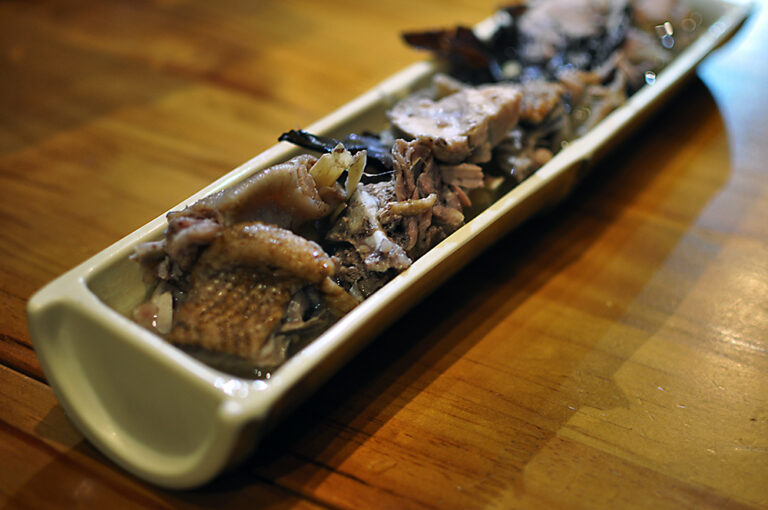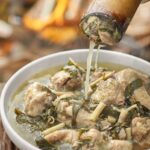Manok Pansoh: An Ethnic Bamboo Chicken Dish from Sarawak
Deep within the cultural tapestry of Sarawak, an iconic dish known as Manok Pansoh (also called manuk pansuh/ayam pansuh) holds a special place among the Dayak community (Iban, Bidayuh, and Ulu people of Sarawak). The name itself, “Manok Pansoh,” translates to “chicken bamboo” in the Iban language, offering a glimpse into the essence of this traditional delicacy.
The preparation of Manok Pansoh involves cooking chicken meat within a freshly cut bamboo stalk, infusing it with a unique aroma and taste. Before the cooking process begins, the chicken is mixed and marinated with an array of aromatic ingredients, including onions, ginger, lemongrass, garlic, torch ginger flower, and galangal. These flavours come together to enhance the succulence of the chicken. Once marinated, the chicken is carefully stuffed into the hollow bamboo stalk, and the opening is sealed with tapioca leaves obtained from the cassava plant. This ingenious method not only imparts a distinct flavor but also allows for convenient cooking in a rustic setting.
The bamboo vessel, filled with the marinated chicken, is then placed near an open fire, allowing the dish to roast slowly. It is essential to position the bamboo next to, but not directly on top of, the open fire. This gentle cooking process ensures that the flavours meld together harmoniously. Remarkably, Manok Pansoh is cooked without the addition of oil or water. Instead, the chicken’s natural juices blend with the other ingredients, creating a flavourful soup that accompanies the cooked chicken and tapioca leaves.
The aroma that permeates the air as the bamboo roasts is truly captivating. The marriage of flavours within the bamboo infuses the chicken with a tantalizing taste that is unique to this dish. Traditionally, free-range village chicken is used, as it imparts a sweeter flavour, elevating the overall culinary experience.
The exact origin of Manok Pansoh remains shrouded in mystery. However, one could surmise that the dish’s creation was born out of necessity, allowing it to be prepared anywhere, even in the absence of kitchen essentials such as pots and gas stoves. Its ingenuity and simplicity make it a beloved culinary tradition passed down through generations.
Initially, Manok Pansoh was primarily served during the Gawai Dayak festival, a celebration of thanksgiving that marks a bountiful harvest and takes place in June each year. However, this delightful dish has gained popularity and can now be found on restaurant menus, night markets, enjoyed during visits to longhouses, and even savoured at Christmas open houses.






1 Response
[…] photo credit: ikanmas.in […]